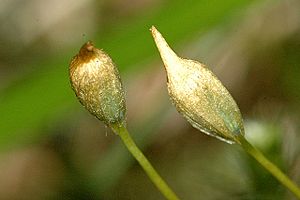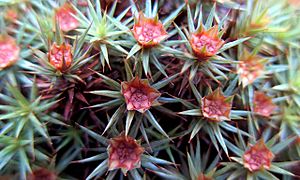Juniper haircap facts for kids
Quick facts for kids Juniper haircap |
|
|---|---|
 |
|
| Scientific classification | |
| Genus: |
Polytrichum
|
| Species: |
juniperinum
|
Polytrichum juniperinum, often called juniper haircap or juniper polytrichum moss, is a type of moss. It stays green all year round and lives for many years. This moss grows almost everywhere on Earth, even in cold places like Antarctica.
What Does Juniper Haircap Moss Look Like?
This moss has reddish stems and grey-green leaves. A cool thing about its leaves is their special red-brown tip. This tip helps tell it apart from a similar moss, the bristly haircap (Polytrichum piliferum), which has green tips.
When the juniper haircap moss is dry, its leaves stand up straight. But when it gets wet, they spread out wide. These mosses usually grow together in thin, tangled mats, not as single plants.
Unlike most mosses, juniper haircap moss has a special system for moving water. It has tiny tubes that carry water from its root-like parts, called rhizoids, up to its leaves. This system is a bit like what you find in bigger plants such as ferns or flowering plants. Because of this unique water system, juniper haircap moss can grow taller than many other mosses.
Where Does Juniper Haircap Moss Grow?
Juniper haircap moss can live in many different places. However, it likes dry, open areas with acidic soil the most. You often find it in spots that have been changed by things like fire or logging.
It also grows on bare soil, rocks, old tree stumps, and along trails. While it prefers dry places, it can sometimes be found in moist woods or near streambanks.
How Does Juniper Haircap Moss Reproduce?

Juniper haircap moss is a dioecious plant. This means that male and female parts grow on separate moss plants. The male plants are easy to spot because they have bright reddish-orange leaves at their tips. These leaves look a bit like tiny flowers.
Like other mosses, juniper haircap moss has a life cycle where the main plant you see is the gametophyte. For the moss to reproduce, it needs water. This water helps tiny swimming cells from the male plant reach the egg cell on the female plant.
Once a new plant starts to grow, it's called a sporophyte. The sporophyte grows right on the female gametophyte. It has a foot, a stalk, and a capsule that holds spores. The capsule has a small lid called an operculum. It also has a hairy hood, called a calyptra, which covers the whole capsule. This hairy hood is why it's called "haircap moss"!


